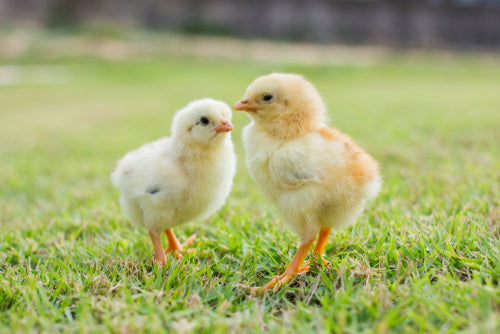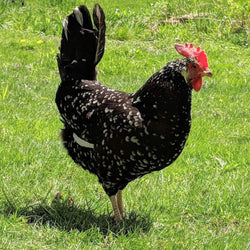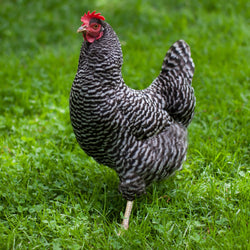page=1/--
Frequently Asked Questions
Here we answer the most commonly-asked questions about ordering, chicken care, and more.
Minimum Hatch Rate Guarantee for Hatching Eggs Sold at My Pet Chicken
Minimum Hatch Rate Guarantee! We want every chicken keeper to experience the joys of hatching eggs but realize that the uncertainty can be a challenge. Nature can be tricky and no hatching egg supplier can promise any particular egg will hatch, especially since the shipment handling and incubating is completely outside of our control. While a 50% hatch rate is generally considered a success, even for commercial hatcheries, we realize low hatch rates can be very frustrating. In response, My Pet Chicken is excited to offer an innovative and industry-leading Minimum Hatch Rate Guarantee, giving you the confidence to hatch...
Read MoreCan different chicken breeds cross-breed?
Yes, they can! There are no problems associated with hatching mixed breed chickens. If you have a rooster in your flock, he will try to breed ALL your hens, nevermind if he is a different breed or even if the hens are different sizes, bantam and large fowl. It can be fun to hatch "mixed" eggs, because you never know what you'll get! Actually, many of the breeds we offer at My Pet Chicken are designer cross-breeds, and the results are spectacular: wonderful plumage colors, fantastic new egg colors, prolific egg-laying, friendly personalities and ultra-hardiness. For instance, we loved our...
Read MoreWhy am I having trouble keeping the temperature steady inside my styrofoam incubator?
Of course we can't know for sure what may be causing the problem in your case, but we can try to mention a few things that might typically cause problems maintaining a steady temperature in the styrofoam incubators. First, if you are reliant on manual turning, opening the incubator to turn your eggs does drop the temperature... but that is pretty temporary and shouldn't cause problems if you are quick. It can help to mark one side of the egg so you can see which have been turned and which haven't. (Use something like soft pencil, that won't soak into...
Read MoreWhy do so few hatcheries sell Red Star hatching eggs?
"Red Stars" are hybrid birds; the rooster is one breed while the hen is another. Because of the genetics of the two breeds, the Red Star chicks are "sex linked," meaning that the color of their down when they hatch is linked to whether the bird is male or female. This means that males hatch out a different color from the females, so they are easy to tell apart. Generally you buy Red Star chicks when you want to be assured of getting all females---they aren't vent sexed like other chicks, so vent sexing errors won't occur. Ordering sex linked...
Read MoreHow do I "calibrate" my incubator thermometer?
It's definitely best to calibrate any new thermometer you are using for your incubator. You need to make sure your incubator thermometer is reading correctly, since even one degree of difference may cause serious problems with your hatch! It's fairly easy to calibrate with crushed ice: your thermometer should read 32 degrees in a mixture of crushed ice and a little water. If it reads, say, 30 degrees, then you can either adjust the thermometer until it is correct (if the style of the thermometer permits adjustment), or else you will at least know your thermometer reads 2 degrees too...
Read MoreHow do I start my own small hatchery business from my home?
That's a complex question. If you would like to turn your home or farm into a hatchery and begin selling baby chicks to other people, we'd first recommend getting NPIP certification so you can be sure that your chicks are free of the worst diseases passed from hen to chick through the egg. We also recommend learning about biosecurity, so you can be sure your breeding flocks will remain clean. You want to be assured you're selling healthy birds to your customers. The next thing you might consider is to join one or more breed clubs for the breeds you'd...
Read MoreHow do I decide between hatching fertile eggs and buying baby chicks?
In almost every case, starting a laying flock with baby chicks will be easier and less expensive than starting one by hatching fertile eggs at home. Don't get us wrong, home hatching is great! But remember that fertile eggs (supplied from any source) are not guaranteed to hatch, because shipping can be so rough on the eggs. With shipped eggs, the average hatch rate is about 50%. That's just the average, though! That means sometimes you will have higher, and sometimes lower. In fact, with eggs, it is possible to do everything right and still not have any hatch. Plus,...
Read MoreIs it ever okay to help a chick out of the shell?
Generally speaking you will NOT want to intervene in the hatching process when incubating fertile eggs. If conditions in the incubator are right, it can take 24 hours for a chick to escape the egg after it has pipped, and that's perfectly natural and not a cause for concern. Often it takes much less time, but 24 hours or so is fairly common, too. If it's been more than 24 hours since the chick first pipped and you have had problems maintaining a high enough humidity during incubation, the problem may be simply that the chick is stuck to the...
Read More- 1
- 2








"The Clubhouse" Coop
Easy to assemble and built to last, the Clubhouse Coop is the perfect starter coop for a small flock.











